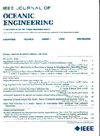系泊-水下可重构导管式水轮机阵列的电磁-水动力-刚体全耦合动力学模型
IF 5.3
2区 工程技术
Q1 ENGINEERING, CIVIL
引用次数: 0
摘要
由于在水生环境中安装、操作、监测、维护、维修和回收水动力涡轮机的费用很高,水动力能源在很大程度上尚未得到开发。提出了基于空气动力学/流体动力学、结构动力学、电力电子学等多学科的设计方法,以降低能源平准化成本。本文提出了一个多物理场耦合集总参数模型,该模型由以下部分组成:1)刚体涡轮阵列;2)系泊缆绳;3)风管式水轮机组;发电机和电力负荷。集总参数多物理场模型是分析性的,保留了其发展背后的物理见解。与高保真度(例如,有限元或分布参数)方法相比,集总参数模型计算成本低,可用于参数调查、设计优化、基于模型的实时调整、控制等应用。在这些应用中,本工作展示了1)基于模型的实时最大功率点跟踪,以改变流速;2)参数调查和设计优化,以降低能源平准化成本,以显示所提出模型的实用性。本文章由计算机程序翻译,如有差异,请以英文原文为准。
A Fully Coupled Electromagnetic-Hydrodynamic-Rigid Body Kinetics Model for Moored-Submerged Reconfigurable Ducted Turbine Arrays
Hydrokinetic energy is largely untapped since the expense to install, operate, monitor, maintain, repair, and recover hydrokinetic turbines in aquatic environments leads to a high levelized cost of energy. Multidisciplinary design methods based on coupled aerodynamics/hydrodynamics, structural dynamics, power electronics, etc., are proposed to reduce the levelized cost of energy. This article presents a multiphysics coupled lumped-parameter model composed of the following: 1) a rigid body turbine array; 2) a mooring cable; 3) ducted turbine units; and 4) generators and electrical loads. The lumped-parameter multiphysics model is analytical, preserving the physical insights behind its development. Compared to high-fidelity (e.g., finite-element or distributed parameter) approaches, the lumped-parameter model is computationally low cost, which allows for applications of parametric investigations, design optimization, model-based real-time adjustment, control, etc. Among these applications, this work demonstrates 1) model-based real-time maximum power point tracking for varying flow velocity and 2) parametric investigations and design optimization for reducing the levelized cost of energy to show the utility of the proposed model.
求助全文
通过发布文献求助,成功后即可免费获取论文全文。
去求助
来源期刊

IEEE Journal of Oceanic Engineering
工程技术-工程:大洋
CiteScore
9.60
自引率
12.20%
发文量
86
审稿时长
12 months
期刊介绍:
The IEEE Journal of Oceanic Engineering (ISSN 0364-9059) is the online-only quarterly publication of the IEEE Oceanic Engineering Society (IEEE OES). The scope of the Journal is the field of interest of the IEEE OES, which encompasses all aspects of science, engineering, and technology that address research, development, and operations pertaining to all bodies of water. This includes the creation of new capabilities and technologies from concept design through prototypes, testing, and operational systems to sense, explore, understand, develop, use, and responsibly manage natural resources.
 求助内容:
求助内容: 应助结果提醒方式:
应助结果提醒方式:


